When it comes to food in Crete, you can take much about what you know about Greek food and put it on the backburner. Yes, you’ll get your typical Greek dishes—moussaka, tzatziki, and souvlaki—but Crete is so vast that at times can feel like a separate destination. And that means it’s developed its own cuisine, shaped by the seasons and proudly tied to the land.
Recipes are passed down rather than reinvented, from simple plates of foraged mountain greens to slow-cooked feasts. Every meal tells you something about the people who made it, and about where it came from.
Don’t expect fussy presentation. Instead, take joy in honest food, packed with flavor: sharp cheeses, great bread, wild herbs, olive oil, and the local fire water, raki. It may seem simple on the surface, but you’ll see just how rich it is when you start to dig in.
Dakos

Dakos
When you first spot a paximadi—a twice-baked barley rusk—you might be excused for thinking they’re designed to be teeth-breakers. Rock hard and rough to the touch, they originated as a practical solution for farmers and shepherds: long lasting, portable, and produced in batches that could feed a household for a month. You’ll find them all over the island in huge bags in bakeries or served with honey for breakfast. But the best way to eat them is as dakos.
One of best-known foods in Crete, dakos sees the rusk softened with olive oil or water, and topped with fresh chopped tomato, soft local cheese, fresh oregano, and more olive oil. Think of it as Cretan bruschetta, only crunchier, saltier, and more rustic—and get used to them, they appear on almost every menu on the island.
Gamopilafo
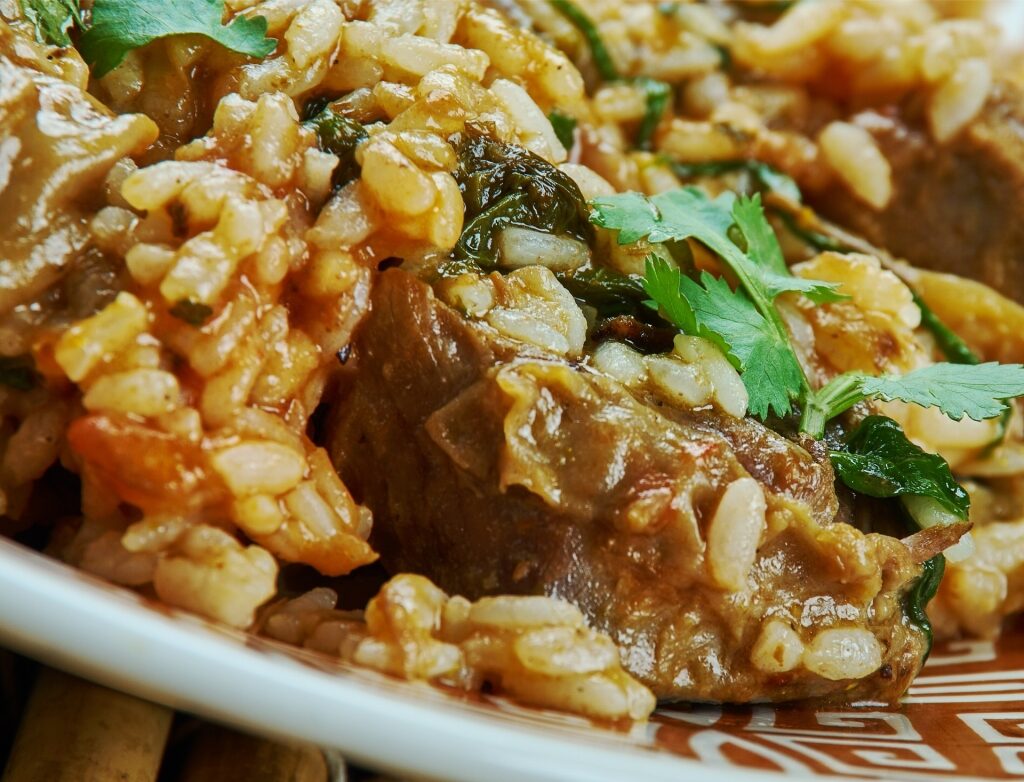
Gamopilafo
If there’s a celebration on Crete, you can bet your bottom euro that gamopilafo will be served. Literally translated as “wedding pilaf”, it’s a wilder, more rustic Cretan version of risotto, or paella. A rich, silky dish, the rice is simmered in lamb or goat broth before being finished with uniquely Cretan staka butter. Its rise to prominence comes from the days when weddings were sprawling, multi-day affairs and the food had to serve a whole village.
Originally, gamopilafa would be found in the mountainous interior where goat and sheep farming dominate to this day. It then spread to the coast, and is now increasingly being seen as a staple in tavernas. Usually the last course before dessert in a celebration meal, it is often accompanied by the slow-cooked meat used to prepare the broth. It’s hearty, delicious, and one of the most uniquely Cretan foods.
Antikristo

Antikristo
Antikristo is Cretan barbecue at its finest, and one of the most popular Cretan foods. Huge slabs of goat or lamb are seasoned, propped upright on a frame of metal stakes, and cooked slowly over an open fire, not in contact with a grill, and on the flames rather than the charcoal. The meat cooks slowly for three, four, five hours, remaining juicy inside and crispy on the exterior.
Antikristo is said to have been around since the Minoan era thanks to shepherding being one of the island’s main occupations throughout history. Knowing how to control the fire is an art form and local chefs take great pride in it. If you see it being prepared in a village taverna, stick around and watch them at work. It can be quite a special experience.
Kalitsounia

Kalitsounia
Kalitsounia are small handmade pies, usually crescent-shaped and designed to be eaten in one or two bites: the ultimate portable comfort food. “Kali” means “good” or “nice” and it’s thought that’s where the name comes from. Grandmas in every Cretan village will have her own recipe that’s been passed down over the years, with some flavors being savory and some sweet.
Fillings can include “horta”, which are wild greens, or mizithra soft white cheese. Sometimes the cheese versions can be drizzled with a little honey too for a sweet and sour version.
Chochlioi Boubouristoi
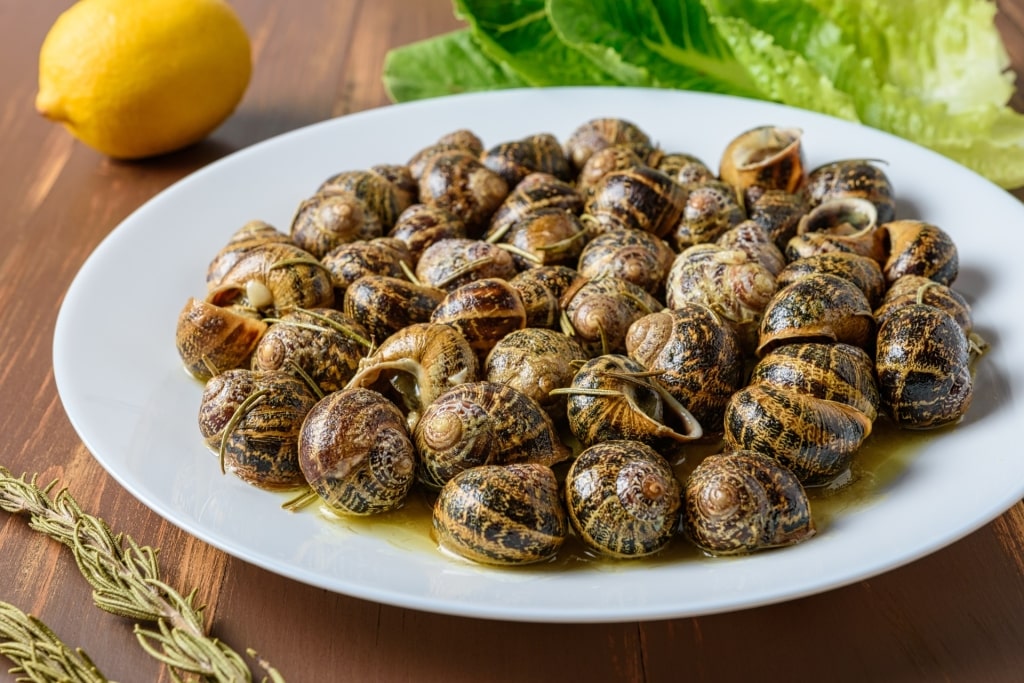
Chochlioi boubouristoi
If someone mentions snails and your mind goes automatically to France, think again. One of the most popular foods in Crete is “chochlioi boubouristi”—fried snails cooked with olive oil, vinegar, and rosemary. If you’re squeamish, don’t be; they are actually delicious when done right. The snails are first cleaned and purged before being boiled, then fried with their shell openings down.
The name boubouristi has several sources with some saying it refers to the bubbling sound they make when being fried, and others from the Cretan word “abubura”, which means face down. Either way, snails were originally real peasant food—a cheap and easy addition of protein to the diet.
A little like lobster, the passing of time has seen them become more of a delicacy and visitors will find boubouristi on many high-end menus, often with high-end prices to match. In some places you may also find a dish called “chochlioi kokkinisto”—snails stewed in tomato sauce, garlic, and onions.
Mizithra & Graviera Cheeses
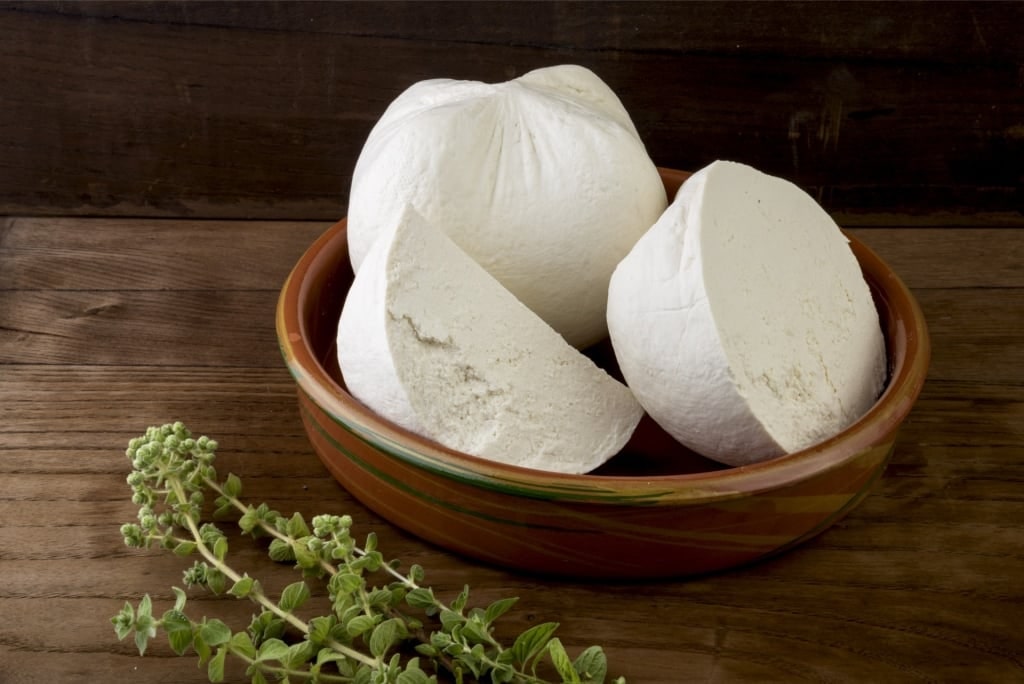
Mizithra
If your knowledge of the cheeses Greece is famous for stops at feta, you’re missing out. Sure, the popular goat’s cheese can be amazing, but the country has so many more excellent cheeses that just don’t get the same recognition, by visitors at least. That’s a real shame, especially for these two fine—and very different—cheeses, which represent some of the best food in Crete.
Mizithra is a soft white cheese from sheep’s or goat’s milk. It’s tangy, creamy and makes an excellent pie filling or topping. Unfortunately, it doesn’t travel well which is why it’s not well known outside Greece.

Graviera
Graviera is a hard cheese—nutty and buttery— and is excellent when fried—you’ll see this as “saganaki” on a menu—as a grated topping for pasta, or thick cut with a slab of homemade bread and a drizzle of local honey.
Wild Greens

Horta
While wandering around Crete, it’s not unusual to see black-clad “yiayiathes”, or Greek grandmothers, backs bent over, pulling leaves from the grounds and stuffing them in a plastic carrier bag. Welcome to the world of “horta”, an incredibly simple dish that needs a bit of a complex explanation.
Horta is actually a collective term for a variety of seasonal foraged edible greens. It can include dandelion, amaranth, chicory, sow thistle, mustard greens, wild fennel, and many more.
The greens are selected, washed, and sauteed before being allowed to cool a little. A drizzle of olive oil and a squeeze of lemon then completes the dish. This is another dish with peasant origins; people have been foraging on the island for millennia.
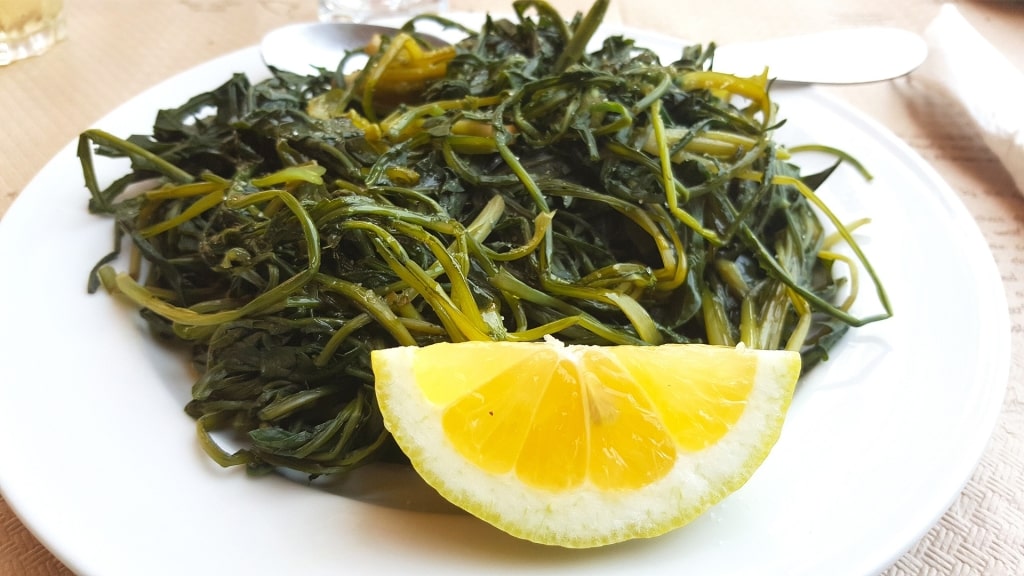
Horta
In times of famine and war, even up to World War II, things like horta and snails may have been the only foods available to the poor. Despite these simple origins, today’s nutritionists love these types of Cretan food, praising them for their nutritional benefits as part of the longevity-promoting Mediterranean Diet.
You can now find cultivated greens sold as horta. They still taste good, but if you want the foraged real thing with all the nutritional benefits that come with it look for “horta tou vounou”—mountain greens—on menus.
Apaki

Apaki
Another dish rooted in the island’s history is apaki, a cut of cured pork loin that dates from the time before the invention of fridges. In rural Crete, especially in mountainous villages of the interior, slaughtering a pig was quite the event and nose-to-tail eating was more than a current culinary trend. Lean cuts of pork were marinated in vinegar and regional herbs and then cold-smoked slowly over wood.
The result is a tangy, smoky, and savory meat that is sliced thin to be served as a meze, or pan fried for inclusion in salads, omelettes, or pasta. It’s common across the island, but particularly in the villages around the towns of Heraklion and near Rethymno. As well as in restaurants, you’ll find it in stores but avoid the more modern vacuum-packed stuff and bag some from a traditional butcher instead.
Sfakiani Pita

Sfakiani pita
Sfakiani pita is one of the more unique types of Cretan food—a thin, round pan-cooked pie filled with soft white cheese, usually mizithra, then drizzled with honey. Best eaten warm as both a dessert and a breakfast item, it originates from the southern region of Sfakia but can now be found all over the island in restaurants, cafés, and bakeries.
Sfakia is a fiercely independent region known for preserving local culture and this is another example of a dish that was historically made by shepherds. The basic recipe—a simple dough, cheese, and honey—reflects the kind of resourceful cooking that defines much of the local cuisine. No waste, no frills, and everything made from scratch.
Read: Best Things to Do in Crete
Xerotigana

Xerotigana
A treat at Cretan weddings, originally provided by the bride’s family to show abundance, xerotigana are now one of the main sweets you’ll find in Crete. Crisp, spiral-shaped pastries, they are made from thin dough which is deep fried until golden; xerotigana means “crisp fried”. Once cool, the pastries are soaked in honey syrup and then sprinkled with sesame seeds, and sometimes cinnamon.
The twisted shape is not by chance—it’s thought to symbolise eternity—and making them was a communal event. Groups of women would gather to produce hundreds ahead of a wedding or baptism. You’ll find some small differences depending where you are on the island. Some people make the spirals tighter, elsewhere they may add chopped walnuts. If offered, eat them by hand—sticky fingers and all.
Staka
One of the most unique Cretan foods, staka is a rich dairy product with its roots in the rural community. Cream is skimmed off from goat’s or sheep’s milk and gently cooked with flour until it thickens. At this point it separates into two things: a clarified butter known as stakovoutyro and a thick creamy paste—the staka itself.
The butter can be used as a cooking fat, stirred into dishes like gamopilafo, while the paste is considered a luxury and is used to enrich rice dishes, eggs, or served warm with bread. It’s the kind of thing you see mostly in homes, particularly in the mountainous interior. If you do see it on a taverna menu, it’s a sign they do things “old-school”.
Raki
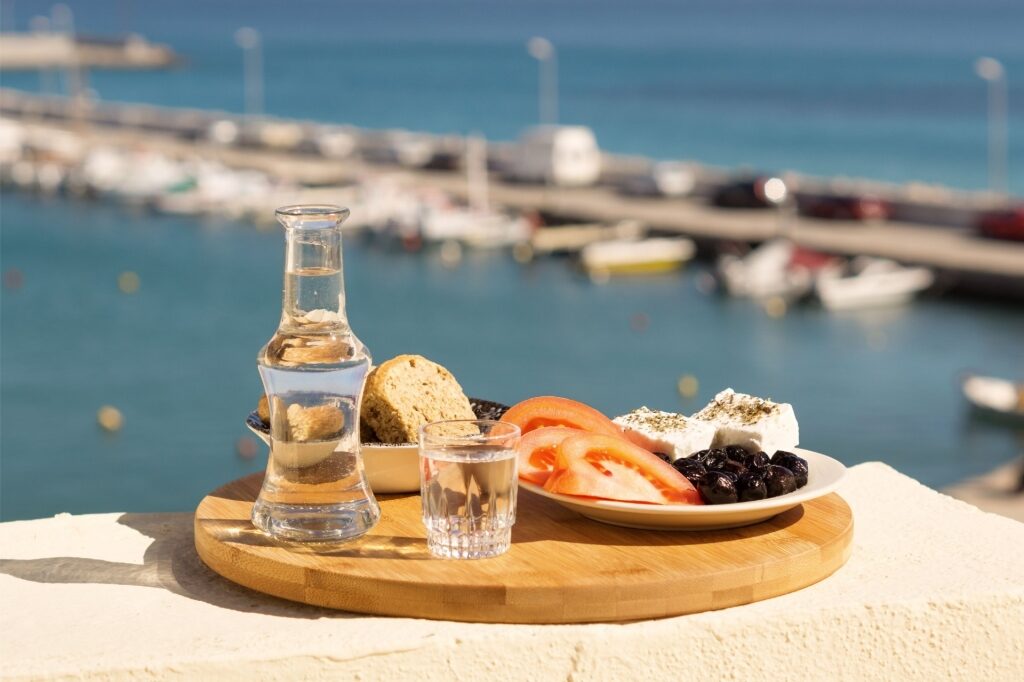
Raki
It’s the law—well not technically, but it may as well be—that raki, traditional Cretan firewater, is served in as many circumstances as possible. Before a meal, after a meal, when you meet someone, if you look sad… the excuses are plentiful and you can only really say “no” if pregnant, driving, or have some other medical condition.
Also known as tsikoudia, it’s usually made on a village still where they distill the remnants of the wine-making process to make a schnapps-style spirit. People will claim the home brew stuff is 40% proof, so it’s wise to err on the side of caution if you’re factoring in how many glasses to go through.
The good news is that raki is actually quite pleasant once you get over the shock, especially when served from the freezer, and it’s sipped rather than slammed, so there’s plenty of chance to hydrate with water in-between.
If you’re a guest somewhere, never pour your own, it will be done for you. And don’t empty your glass too quickly, unless you want it refilled even quicker.
On the rare occasion where the temperature drops, rakomelo is a pleasant warmed version with the addition of honey.
Cretan Food FAQs
Is Crete a good food destination?

Restaurant in Heraklion
You may as well ask if the Acropolis has history. Crete’s huge size—the largest island in Greece and the fifth largest in the Mediterranean—amazing climate, and fertile soils make for some incredible food, mostly home-grown. And just as the island could easily be its own country, the food here can be quite different to what you’ll find in the rest of Greece.
What dish is Crete most famous for?

Dakos
If you ask a tourist—and Greeks from elsewhere would be considered tourists—they’ll probably say the best known food in Crete is dakos. But if you’re Cretan, it has to be gamopilafo. Served at every celebration, usually with abundant raki and the occasional firing of shotguns into the air, in joy, not anger, it’s about as unique as Cretan food gets.
What time does dinner typically start in Crete?

Restaurant in Chania
Like all Greeks, Cretans tend to eat later in the evening, around eight, nine or even 10 pm. It’s too hot to eat in the afternoon, and many people nap then, anyway. Evening meals can last a good while. It’s not unusual for visitors to mistake the starters as the whole meal, but then a main course turns up, just when you think you can’t eat any more.
Are there any food customs I should know about?
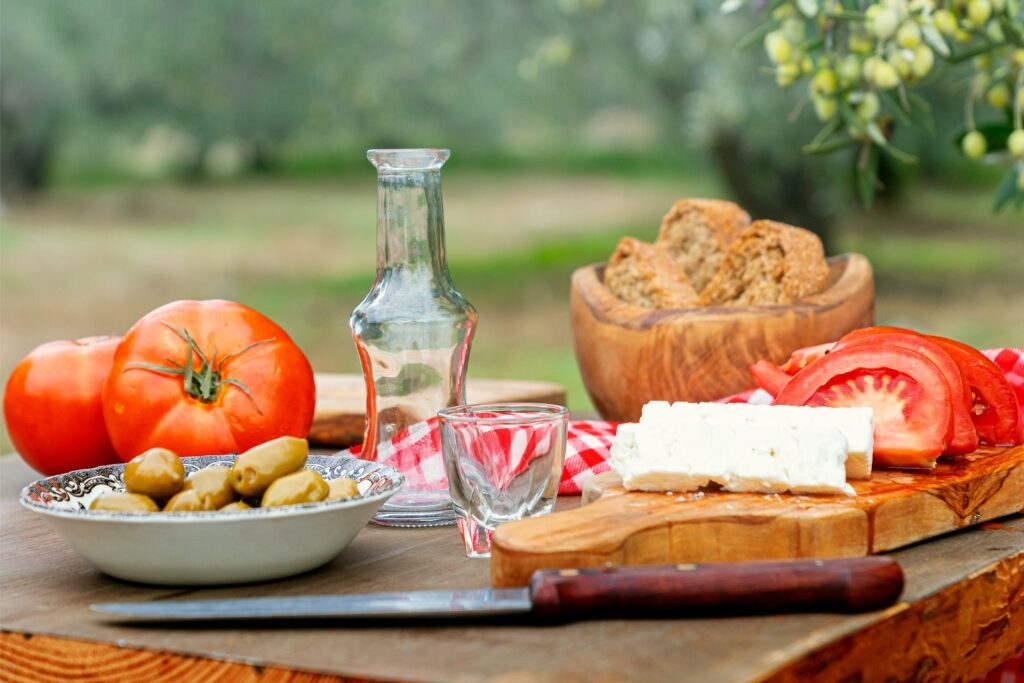
Raki
If you are invited to an afternoon meal, cancel all plans. It’s likely to go on well into the night and will include some form of dancing and lots of raki. Remember at all meals, bread is a third utensil alongside a knife and fork. Use it for dipping, scooping, and dabbing up foods. Dessert doesn’t need to be ordered, it’s usually offered for free at the end of a meal in the form of fresh fruit or sweet pies. Raki will almost certainly feature—so take it steady.

Chania
Discover the cuisine of this fascinating island for yourself. Browse Celebrity’s cruises to Crete and plan your Greek adventure.


